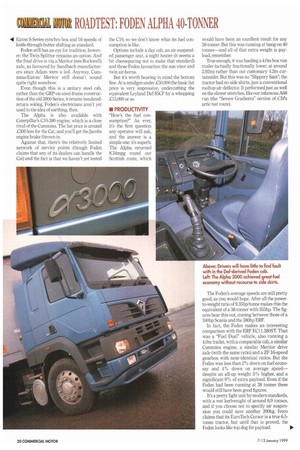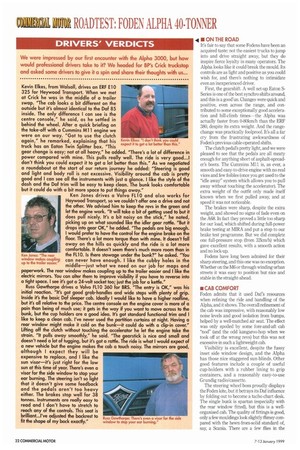GHT FOR
Page 20

Page 22

Page 24

Page 25

If you've noticed an error in this article please click here to report it so we can fix it.
Foden's traditional niche is the owner-driver sector where its custom-truck approach is much appreciated. But the latest Alpha range is aimed squarely at fleet operators— and just to make it even more interesting, we tested the newcomer at a full 40 tonnes. This Foden has a lot riding on it...
0 perators will go to great lengths for better productivity: a different set of tyres, an altered axle ratio or an aerodynamic kit might improve fuel consumption by one or two percent, while alloy wheels will give you a couple of hundred more kilos in payload.
But it's difficult to transform the efficiency of a truck unless you cheat—and now it's legal to cheat. With the advent of the 40-tonne limit, you can load an extra two tonnes on your trailer without having your collar felt...as long as you can afford the VED, that is.
But what does it do to your truck's performance? Do you need a tarmac-rippling 500hp monster to do justice to forty tonnes, or will the average driver find it hard to tell the difference? Foden has helped us answer that question as part of the first full test of its Alpha range.
• PRODUCT PROFILE
The Alpha reflects a major change in Foden's marketing philosophy, as the Paccar-owned Sandbach firm has been able to use the resources of its sister company Daf. It's no secret that the Alpha's cab is based on Da's 85 Series, a well-liked mainstream design that will attract mainstream customers; this could allow Paden to move beyond its traditional owner-driver customers and into the lucrative high-volume fleet markets.
The Alpha's specification certainly puts it straight into the fleet sector. There's a meatand-potatoes single-bunk sleeper cab (we suspect that the bunk might be more for residual values than for actual use) and the ever-familiar Cummins M11 engine in 380hp trim. Fleet and agency drivers needn't be daunted by Foden's traditional constant-mesh or Twin Splitter gearboxes either: this model offers the 110.
41 Eaton S-Series synchro box and 16 speeds of knife-through-butter shifting as standard. Foden still has an eye for tradition, however: the Twin Splitter remains an option. And the final drive is via a Mentor (nee Rockwell) axle, as favoured by Sandbach manufacturers since Adam were a lad. Anyway, Cummins/Eaton/ Mentor still doesn't sound quite right somehow.
Even though this is a unitary steel cab, rather than the GRP-on-steel-frame construction of the old 3000 Series, it retains insulatedreturn wiring. Foden's electricians aren't yet used to the idea of earthing, then.
The Alpha is also available with Caterpillar's C10-380 engine, which is a close rival of the Cummins. The list price is around £300 less for the Cat, and you'll get the Jacobs engine brake thrown in.
Against that, there's the relatively limited network of service points (though Foden claims that any of its dealers can handle the Cat) and the fact is that we haven't yet tested the C10, so we don't know what its fuel consumption is like.
Options include a day cab, an air-suspended passenger seat, a night heater (it seems a bit cheeseparing not to make that standard) and those Foden favourites: the sun visor and twin air-horns.
But it's worth bearing in mind the bottom line. At a smidgen under £50,000 the basic list price is very impressive, undercutting the equivalent Leyland Daf 85CF by a whopping £15,000 or so.
• PRODUCTIVITY "How's the fuel con.. sumption?" As ever, it's the first question any operator will ask, and the answer is a simple one: it's superb. The Alpha returned 8.34mpg round our Scottish route, which would have been an excellent result for any 38-tonner. But this was running at bang-on 40 tonnes—and all of that extra weight is payload, remember.
True enough, it was hauling a 4.0m box van trailer (actually fractionally lower, at around 3.92m) rather than our customary 4.2m curtainsider. But this was no "Slippery Sam"; the tractor had no side skirts, just a conventional rooftop air deflector. It performed just as well on the slower stretches, like our infamous A68 run (the "Severe Gradients" section of CMs artic test route).
The Foden's average speeds are still pretty good, as you would hope. After all the powerto-weight ratio of 9.35hp/tonne makes this the equivalent of a 38-tonner with 355hp. The figures bear this out, coming between those of a 340hp Scania and the 380hp ERE In fact, the Foden makes an interesting comparison with the ERF EC11.380ST. That was a "Fuel Duel" vehicle, also running a 4.0m trailer, with a comparable cab, a similar Cummins engine, a similar Mentor drive axle (with the same ratio) and a ZF 16-speed gearbox with near-identical ratios. But the Foden was less than 2% down on fuel economy and 4% down on average speed— despite an all-up weight 5% higher, and a significant 9% of extra payload. Even if the Foden had been running at 38 tonnes these would still have been good figures.
It's a pretty light unit by modern standards, with a wet kerbweight of around 6.9 tonnes, and if you choose not to specify air suspension you could save another 200kg. Iveco claims that its EuroTech Cursor is a true 6.5tonne tractor, but until that is proved, the Foden looks like top dog for payload. 14 NON THE ROAD
It's fair to say that some Fodens have been an acquired taste: not the easiest trucks to jump into and drive straight away, but they do inspire fierce loyalty in many operators. The Alpha looks like it could break the mould. Its controls are as light and positive as you could wish for, and there's nothing to intimidate even an inexperienced driver, First, the gearshift. A well set-up Eaton 5Series is one of the best synchro shifts around, and this is a good'un. Changes were quick and positive, even across the range, and contributed to some exceptionally good acceleration and hill-climb times—the Alpha was actually faster from 0-80km/h than the ERF 380, despite its extra weight. And the rangechange was practically foolproof. Its all a far cry from the frustrating awkwardness of Foden's previous cable-operated shifts.
The clutch pedal's pretty light, and we were pleased to see that the pedals are all meaty enough for anything short of asphalt-spreader's boots. The Cummins Mu l is, as ever, a smooth and easy-to-drive engine with no real vices and few foibles (once you get used to the "idle away" system which allows you to pull away without touching the accelerator). The extra weight of the outfit only made itself known when we first pulled away, and at speed it was not noticeable.
The brakes were sharp, despite the extra weight, and showed no signs of fade even on the A68. In fact they proved a little too sharp for our load, which shifted during full-power brake testing at MIRA and put a stop to our brake test programme. But we did complete one full-pressure stop (from 32km/h) which gave excellent results, with a smooth action and no lock-up.
Fodens have long been admired for their sharp steering, and this one was no exception. Whether on the M6 or through winding urban streets it was easy to position but nice and stable in the straight-ahead.
• CAB COMFORT
Foden admits that it used Daf's resources when refining the ride and handling of the Alpha, and it shows. The overall refinement of the cab was impressive, with reasonably low noise levels and good isolation from bumps, helped by a well-matched air seat. The effect was only spoiled by some fore-and-aft cab "nod" (and the odd karigaroo.hop when we took off at the wrong revs) but this was not excessive in such a lightweight cab.
Visibility is excellent, despite the fussy inset side window design, and the Alpha has those nice staggered sun-blinds. Other good features include a couple of useful cup-holders with a rubber lining to grip containers, and a reasonably easy-to-use Grundig radio/cassette.
The steering wheel boss proudly displays the Foden kite, but it betrays its Daf influence by folding out to become a tacho chart desk. The single bunk is spartan (especially with the rear window fitted), but this is a wellorganised cab. The quality of fittings is good, only a few mouldings look slightly flimsy compared with the hewn-from-solid standard of, say, a Scania. There are a few flies in the ointment, of course. We hated the antiquelooking headlight control (it should have been made from Bakelite) and there was an irritating tizz from the gear-lever collar-something that could probably be sorted out at the PDI.
• SUMMARY
This test proves beyond doubt that 40-tonners are a worthwhile investment if you're going to operate at maximum gross weightbut only if the VED is acceptable, and we won't know that until March. On the road the trade-off in fuel consumption and performance compared with a 38-tonner is minimal, while the payload gain is substantial. It's worth repeating: that extra two tonnes is all payload.
The years of development of 40-tonners on the Continent mean they are no more difficult to drive than 38-tonners, as long as your basic power-to-weight ratio is sufficient.
One thing's for sure: Foden deserves to be taken very seriously as a builder of fleetfriendly tractors, The Alpha 3000 behaved well round our demanding Scottish test route, tackling the most difficult sections with ease. This is a reasonably priced, well developed, sensible truck which would be welcome in any market.
With the right support and some marketing input from Paccar, the twenty-first century could well be kite-shaped...
L by Toby Clark
































































































